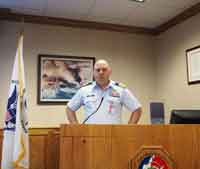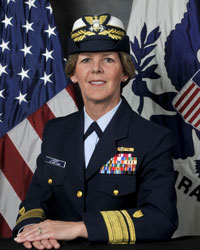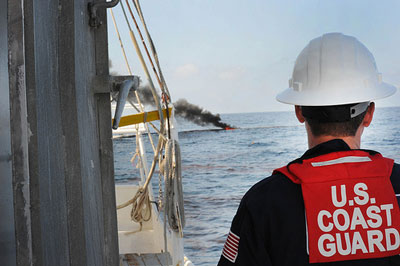In early April 2010, SLD discussed the challenges facing the USCG 8th district in managing, safety and security in the Gulf region.
As the slide show accompanying this interview shows, the scope and size of the territory facing the men and woman of the USCG serving in the 8th district is immense.
The district covers all or part of 26 states. Although a single district, it has three distinct regions, from the Gulf to the Midwest.
Of course, the offshore oil drilling efforts of the Gulf operate within this district as well.
There is no need to tell the readers of this website that the challenges associated with oil drilling are going up not down.
This is especially so because the new offshore efforts will be further and deeper than the current offshore activities.
It will be more akin to the North Sea than to current Gulf offshore drilling.
And the USCG will need additional resources for inspections, helos and ships to monitor and to ensure compliance with the national effort to shape a deep sea offshore oil and gas enterprise.
[slidepress gallery=’uscg-8th-district-presentation’]
“The 8th covers all or parts of 26 states from Mexicoup to Canada and from the Rockies to the Appalachians.
Roughly 35 percent of the US population or a 100 million
people reside within the boundaries of the 8th District.
SLD: Could you describe the size and nature of the 8th district?
Captain Arenstam: The 8th covers all or parts of 26 states from Mexico up to Canada and from the Rockies to the Appalachians. Roughly 35 percent of the US population or a 100 million people reside within the boundaries of the 8th District. Our workforce here includes 4,000 active duty and reserve military forces, 300 civilian employees, and 6,000 auxiliaries. Unlike any of the other Coast Guard districts, the 8th District has three distinct geographic regions. To the north is the part of the 8th District we refer to as the Western Rivers or the Old 2nd District. This The region covers all or part of 20 states and contains over 10,000 miles of waterways including the Mississippi, Missouri, the Illinois, the Ohio, Tennessee, Arkansas rivers, and all their tributaries. Up in this region there are three sectors: Sector Ohio Valley, Sector Upper Mississippi River, and Sector Lower Mississippi River. There are 10 MSUs, 18 river tenders, and two aids-to-navigation teams.
So if you think about going all the way up to the North Dakota floods, going all the way over to Pittsburg, we got Pendleton, West Virginia, that whole river system there. So basically if it flows to the Gulf of Mexico, it’s ours.
SLD: Not only do you have a big swath of territory, there are also a number of game changers coming into your waterways, ranging from the large liquid natural gas ships to the larger container ships coming through the enlarged Panama Canal.
Admiral Landry: These are major challenges and part of how this challenge is being viewed is through the eyes of the major ports in the region. All the major ports are trying to sort through how to be able to meet the challenges and to remain competitive as shipping companies look at the best ports through which to operate.
The other major challenge is the deep offshore oil and gas enterprise. The companies are going to be drilling and working so much farther offshore and deeper; the offshore energy sector is a huge game changer field technology-wise and what they’re doing now it pales in comparison two years ago. They’re not only going 10,000 feet deep; they’re also drilling deeper than before.
Captain Arenstam: The next zone I will talk about is the coastal zone, which I call the traditional zone here on the coast. It includes all or part of six states and contains more than 8,000 miles of coastline and nearly 1,300 miles of the intercoastal waterway. The 8th District ports in this region receive approximately 26,000 deep-draft vessels annually, which equates roughly to 27 percent of US deep-draft arrivals and nearly 90,000 towing vessel transits per year. In New Orleans alone in 2008, there were 46,000 towing vessel transits.
The 8th District coastal region is divided into four sectors: To the west there is Sector Corpus Christi and Sector Houston Galveston. Together they have six small boat stations. Air station Corpus Christi operates as an integral part of Sector Corpus Christi while air station Houston operates under the Operational Control (OPCON) of D8.
To the east, there is Sector New Orleans and Sector Mobile. Together they have nine small boat stations. Air Station New Orleans operates under the OPCON of D8. Aviation Training Center (ATC) Mobile, which is a Coast Guard Headquarters unit but provides direct aviation support to D8. Collectively among the four coastal sectors, there are 17 patrol boats, 9 aids-to-navigation cutters and 13 ANTS (aids to navigation teams).
Finally, the unique feature of the 8th District is the offshore sector. It captures the intercontinental shelf, oil and natural gas industry. Within this region there is 6,500 oil and gas wells; 4,000 oil or gas production platforms and over 800 of which have full-time crew support.
There are 116 Mobile offshore drilling units 51 of which are stacked, some which are crude and some are not. There are 30,000 workers offshore on any given day. This infrastructure accounts for 30 percent of our domestically produced oil and 23 percent of our domestically produced natural gas.
Admiral Landry: This is the only district in the country where there is offshore zone, the district commander services, the federal maritime security coordinator post 9/11, the FMSC role that you see in sectors, federal maritime security coordinator under the MTSA 2002, this is the only one that the offshore sector is handled from the district. We are concerned with the security of the LOOP.
SLD: What is the LOOP?
Admiral Landry: The Louisiana Offshore Oil Platform, which is a mooring for, imported crude that gets pipelined to the US.
SLD: How do you address security in the offshore zone? I frankly think that it is a challenge beyond the resources of the USCG and perhaps the US Government?
Admiral Landry: First with regard to search and rescue, it is absolutely a partnership with the offshore oil and gas industry. The private sectors have to have a certain inherent capability themselves on the offshore platforms, but they also allow us to use their helo ports on some of these larger platforms. If we’re flying a search and rescue mission from the air stations offshore to rescue somebody whether it’s on the platform itself or if it’s a commercial fisherman in the area or a recreational boater, we can refuel on their fuel ports and we can continue on with their mission. So it’s a very much a cooperative effort in terms of the safety piece.
That’s one aspect, the other aspect obviously is the safety after storms, hurricanes, things like that, the safety of the platform itself; and we work with them. We do so through a Mineral Management Service or MMS protocol for that effort.
If it’s security, it’s the same thing. It’s integrated; it’s absolutely the inherent self-security that they provide because they’re required after 9/11 as a facility to have a security plan. Then the security we provide is for high threat scenarios. And frankly, it would take the whole government to do the work if we had a threat against the offshore including NORTHCOM and DOD assets.
Captain Arenstam: It would be close to impossible to have enough Coast Guard assets to police this entire region given the resources we currently have available. We do not have a current requirement for a 1.0 coverage factor to patrolling this vicinity.
SLD: Could we discuss further the deep-sea offshore oil and gas enterprise concept?
Captain Arenstam: Future oil exploration, as Admiral has mentioned, is well offshore in the very deep water. There is recent discovery activity in the lower tertiary geological formations that extends to 175 miles from the nearest land in water depths greater than 9,000 feet.
Technology is new to the Gulf like the floating production storage and offloading facility, the FPSO are being employed for production. The first one in the United States is here off the coast already. It’s anchored off of Morgan City
SLD: What is an FPSO?
Captain Arenstam: It stands for a Floating Production, Storage, and Offloading. It’s common in the North Sea and other parts of the world but the US hasn’t allowed it.
SLD: So this is our first one?
Admiral Landry: The LOOP is just a gas station for importing crude. This is actually going to be, not only an import but also a production facility.
SLD: And this is parked where?

Captain Arenstam: Well, currently it’s anchored off of the coast of Louisiana but it will be out offshore.
SLD: So this is a new technology that is expanding. What you can say about this region is they continue to bring on new technologies and new systems to support energy both production and importation. So this will be a dramatic increase in the challenge, which you will be facing in the years ahead?
Captain Arenstam: Correct. There are currently 10 additional FPSO’s, which are floating production facilities at various stages of construction headed to the Gulf of Mexico. This will bring the total to 48 by the end of 2010. Discoveries in the Walker Ridge area are thought to be approximate of the crude of Bay Fields as well. This is a whole new game.
SLD: This will be producing and processing facility. In contrast, the LOOP is a floating gas station?
Captain Arenstam: The loop is not really a producer but is the nation’s only deep-water oil port. It’s located 18 miles offshore. It receives roughly 13 percent of the nation’s imported oil, approximately 1.2 million barrels per day. This oil is pumped inland approximately 50 miles and stored in caverns total capacity of 50 million barrels where it connects by pipeline to roughly 50 percent of the US refining capability. The Coast Guard provides several aircraft over flights of the LOOP each week. We do cop on the beat in the air patrols of the loop in the offshore district.
SLD: The Gulf is a crucial contributor to the national economy. Can you give a picture of the contribution?
Captain Arenstam: The Gulf of Mexico itself plays a crucial role regarding the production and import of oil for our nation’s energy needs. Twenty-five percent of the domestic oil production occurs in the Gulf with 18 major platforms accounting for half of that total. The destruction of a single one of these platforms in the Gulf would negatively impact our nation’s economy.
Twenty-five percent of the nation’s oil imports occur in the Gulf through lightering operations off the coast. The lightering zones are established to accommodate the Very Large Crude Carriers and Ultra Large Crude Carriers. There’s four designated lightering zones used by single-hull tankers until 2015 and then there’s six traditional lightering areas by double-hull tankers and the largest and busiest in the US receives 30 percent of the nation’s crude.
SLD: Can the Gulf ports take the new double-hull tankers?
Captain Arenstam: You have ultra large crude oil tankers, which cannot get into US ports. These are drawing 50 to 60 of drag, which are never ever going to get into Houston.
Instead of delivering at a refinery, they have to do it offshore to smaller tankers like a shuttle service of oil. Sometimes, they could put in a pipeline loop that goes through a pipeline but sometimes they lighter the ships and the ships bring them in.
Admiral Landry: It is a new approach to the oil distribution system and if you look at Singapore or ports around the world, they work containers the same way. Huge container ships that offload containers so the offshore becomes a port in itself, a geographic port even though it’s water and that’s how they do it in Asia so just to deal with the lack of land.
———-
***Posted May 6th, 2010
For an overview on the Deepwater Horizon challenge and the government’s response see the following:



